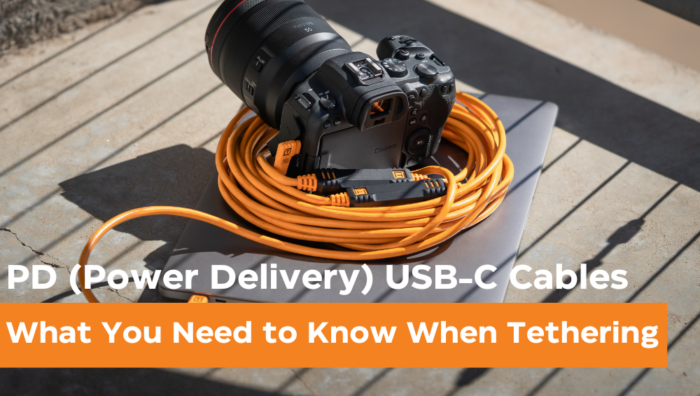
In tethered photography, where every connection counts, TetherPro USB-C Cables stand out as the pinnacle of reliability and performance. Let’s dive into the intricacies of some updated features for Tether Tools cables including power delivery, uni-directional data transfer, construction of the cable, and the latest USB-C technology and cables that Tether Tools offers for photographers, videographers, digitechs, and creators’ specific needs.
What is Power Delivery or PD?
Power Delivery (PD) is a technology deployed with the USB-C standard which allows a variety of high powered devices to be charged via the cable. The cable’s internal IC chip does a handshake between the power source and device needing to be powered, to ensure the correct amount of power is being delivered to the device. This feature in your camera allows for faster charging and more flexible power delivery over a single cable. Cameras with USB-C ports are often able to power the camera and/or charge the battery through USB. While this is a convenient feature, this can sometimes cause connection issues during tethering.
Most camera manufacturers recommend turning USB Power Delivery / Charging OFF during tethering in order to ensure the most stable connection possible. Some camera manufacturers’ settings affect how the camera behaves when connected via USB. These settings can prevent the camera from being recognized properly by tethering software. Please be sure to check your camera manual for unique tethered connection settings.
To learn how to turn off your power delivery setting in your camera click here.
How Does PD Affect Your Tethering Experience
Due to hardware limitations, there are several camera models that currently do not allow for power delivery to be turned off. Due to the large amount of data flowing through the cable, during a tethering session, there are known compatibility issues. This may not cause tethering issues right away, but over time not being able to turn off power delivery could cause dropped connections and tethering frustrations.
If you do not want to regularly manage the camera power settings or your camera is unable to turn off power delivery, the best solution to avoid dropped connections is a dedicated tethering cable which does not have power delivery.
How does the 1.5A downstream charging work if there is no PD in the cable?
The USB 3.2 standard has two methods for transferring power. All USB cables have a built-in method for transferring low levels of power. Just as the USB standard stipulates transfer speed, it also stipulates power draw as part of the standard. In the case of USB 3.0 and above, that is 5V 1.5A or 7.5 watts. This will charge smaller devices like phones and tablets. This low power will not affect tethering sessions. The USB 3.2 standard introduced a secondary (parallel) method for transferring power called Power Delivery (PD). This method allows for much higher levels of power to be transferred. Power Delivery can allow for up to 240W of power. This Power Delivery feature is known to cause instability in certain types of connections, including tethered connections.
Maximizing Efficiency with Uni-Directional Communication:
Tether Tools’ new data priority cables utilize optimized uni-directional communication to maximize efficiency in data transfer. Uni-directional cables communicate data and command bi-directionally, but necessitate that one device acts as the host (computer) to the connection and the other device as data source (camera). This allows for the most efficient and reliable method to transfer large data files. The devices will be able to fully communicate with each other, as happens with bi-directional cables. There are multiple communication ‘lanes’, so camera control can occur simultaneously as the images transfer.

Photographers have unique requirements transferring enormous image and video data files near instantly. TetherPro Uni-Directional cables prioritize this data flow requirement to increase speed and reliably. Tether Tools new Optima 10G Cables are highly specialized to eliminate power issues and prioritize data transfer direction for maximum efficiency and reliably.
The Optima 10G Cables with dedicated data transfer are specifically designed to ensure stability and lightning-fast 10Gbps transfer speed while eliminating power surges that can cause interruptions or dropped connections while tethering. The new rugged design features reinforced TetherBoosts with high-impact ridges, which protect the internal IC chipsets and maintain consistent speed over long distances.
Craftsmanship that Exceeds Expectations:
Tether Tools takes pride in crafting cables that exceed industry standards in both reliability, connectivity, and durability. TetherPro USB-C Cables are built to last, with quality materials and precision engineering that ensure reliability in any shooting environment.

- Rugged Housing: Custom-formulated, water-resistant housing prevents kinking and increases cable life, keeping your setup clean and hassle-free.
- Triple-Layer Shielding: With triple-layer, copper-braided shielding, TetherPro cables maximize conductivity and data transfer speed, ensuring seamless image transfer every time.
- Cool and Reliable: Custom LDPE/HDPE insulation keeps TetherPro cables running cool and prevents overheating, even during extended shooting sessions.
- Signal Protection: Outer aluminum shields protect against external signal interference, while inner aluminum mylar shielding optimizes data transfer and protects against electrical noise.
- Optimal Data Transfer: TetherPro cables feature oxygen-free, twisted copper wire for optimal data transfer, delivering unparalleled clarity and precision in your images.
Find your cable today and experience the difference for yourself. With unrivaled reliability and performance, Tether Tools has your tethered photography needs covered.


